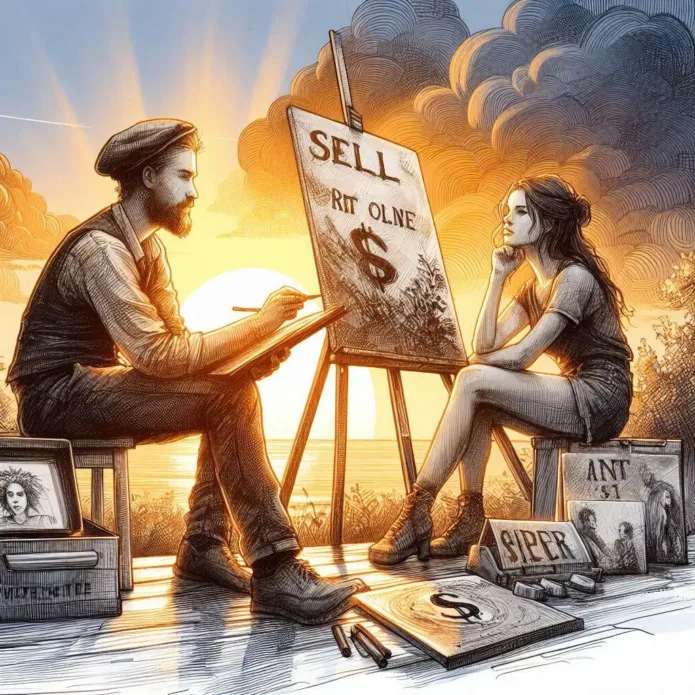How can Online stores for Artists be launched? Some people think it is a difficult thing to open an online store, the truth is that it has never been easier these days, we” tell you exactly what to do in this article.
How to Open an Online Store for Artists on Sellfy?
Setting Up Your Online Store for Artists on Sellfy
Here’s a step-by-step guide on how to open an online store for artists on Sellfy:
1. Create a Sellfy Account:
- Sign up for a free or paid Sellfy account.
2. Customize Your Store:
- Choose a theme or design your own.
- Add your logo, branding, and other customizations.
3. Upload Your Art:
- Upload high-quality images of your artwork.
- Provide detailed descriptions for each piece.
4. Set Pricing:
- Determine the price for each piece of artwork.
- Consider factors like your experience, the complexity of the work, and market trends.
5. Configure Shipping (if applicable):
- If you’re selling physical prints or merchandise, set up shipping rates and options.
6. Set Up Payment Options:
- Choose payment methods like credit cards, PayPal, or Apple Pay.
7. Promote Your Store:
- Share your store on social media, your website, or through email marketing.
- Use relevant hashtags and keywords to improve visibility.
8. Engage with Customers:
- Respond to inquiries and comments promptly.
- Build a community around your art.
Additional Tips:
- Offer exclusive content: Provide limited-edition prints or behind-the-scenes glimpses.
- Create a mailing list: Collect email addresses to send updates and promotions.
- Optimize for SEO: Use relevant keywords to improve your search engine ranking.
- Consider partnering with other artists: Collaborate on projects or cross-promote each other’s work.
By following these steps and leveraging Sellfy’s features, you can create a successful online store for your art.
Further Readings about Sellfy: A Comprensive Review of Sellfy eCommerce Platform

Sell Art on Sellfy – Is it Lucrative?

Selling art on Sellfy can be lucrative if approached strategically. Here are some factors to consider for maximizing profitability:
1. Low Overhead Costs
- Unlike physical art sales that require printing, shipping, and handling, selling digital art (illustrations, designs, photography, etc.) eliminates these costs. You only need to create the digital files once and can sell them repeatedly with no additional expenses.
2. Global Reach
- Sellfy allows you to sell to a global audience. Your art is available 24/7, giving you access to customers from all over the world. You can leverage social media, email marketing, and SEO to drive traffic to your store.
3. Recurring Income Potential
- You can generate passive income by selling art pieces, templates, or design packs that customers can download instantly. Offering prints or custom orders can add another revenue stream if desired.
4. Scalable Business Model
- Once your art is created and uploaded, you can sell it to unlimited buyers. You also have the option to bundle products, offer subscriptions, or sell exclusive licenses to maximize your earnings.
5. Sellfy’s Built-in Marketing Tools
- Sellfy offers integrated email marketing, upselling, discount codes, and analytics to help you promote your art. This makes it easier to reach your audience and drive repeat sales.
6. Pricing Flexibility
- You can experiment with different pricing models based on demand, quality, and exclusivity. Sellfy allows you to offer discounts, run sales, or create premium collections to attract buyers.
7. Niche Market Demand
- Digital art is in high demand for personal use, websites, social media, content creation, and businesses. If your art caters to a specific niche (e.g., fantasy, minimalist design, or abstract photography), you can find dedicated buyers willing to pay premium prices.
8. Competition
- While Sellfy provides an easy platform to sell, competition from other artists is a factor. You need to stand out with unique artwork, excellent marketing, and a strong brand identity. Building an engaged audience on social media or art platforms can boost your store’s success.
9. Potential Challenges
- Success may take time. Like any online business, selling art requires consistent effort in marketing, creating high-quality work, and engaging with customers.
- Pricing digital art appropriately can be tricky. If prices are too low, it can devalue your work; if too high, it may scare away potential customers.
Conclusion: Is It Lucrative?
Selling art on Sellfy can be lucrative, especially for digital artists, photographers, and designers. The platform provides an easy-to-use interface and several tools to help monetize your art. However, success depends on the quality of your art, marketing efforts, and finding the right audience. With consistency and a strong brand, many artists generate significant income from selling their digital works.

Art Online Sites – What are the Top Ones?

There are many excellent platforms for selling art online. Here are some of the top options:
Dedicated Art Marketplaces:
- Artfinder: A global online marketplace for buying and selling original art.
- Saatchi Art: A popular platform for emerging artists.
- Artpal: Offers a range of features for artists and buyers.
- Artfinder: A global marketplace for buying and selling original art.
E-commerce Platforms:
- Sellfy: A dedicated e-commerce platform for digital arts and downloads.
- Etsy: A popular platform for handmade and vintage items, including art.
- Shopify: A versatile platform that can be used for selling both physical and digital art.
- BigCommerce: Another powerful e-commerce platform suitable for artists.
Social Media Platforms:
- Instagram: A popular platform for showcasing art and connecting with potential buyers.
- Facebook: Create a Facebook Page for your art business and sell directly through the platform.
- Pinterest: Use Pinterest to create visual boards of your artwork and attract potential buyers.
Your Own Website:
- Build your own website: Create a website specifically for your art business to have full control over your brand and customer experience.
When choosing a platform, consider factors like:
- Fees: Compare the fees charged by different platforms.
- Target audience: Determine which platforms are most popular with your target audience.
- Features: Evaluate the features offered by each platform, such as payment processing, marketing tools, and community features.
- Customization: Assess how much control you have over your online store’s design and functionality.
By carefully evaluating these factors, you can select the best platform to showcase and sell your art online.

Art Online Store – Can It Succeed?

Absolutely, an art online store can be successful! With the growing popularity of online shopping and the increasing accessibility of digital platforms, there are many opportunities for artists to reach a wider audience and sell their work online.
Here are some factors that contribute to the success of an art online store:
- Quality of Art: Creating high-quality, unique, and visually appealing artwork is essential.
- Effective Marketing: Promoting your art through social media, online advertising, and other channels is crucial.
- User Experience: Ensuring your online store is easy to navigate and provides a positive user experience is important.
- Pricing Strategy: Setting competitive and fair prices for your artwork is essential.
- Customer Service: Providing excellent customer service can help build trust and loyalty.
By focusing on these areas, you can increase your chances of success with your art online store.




Leave a Reply